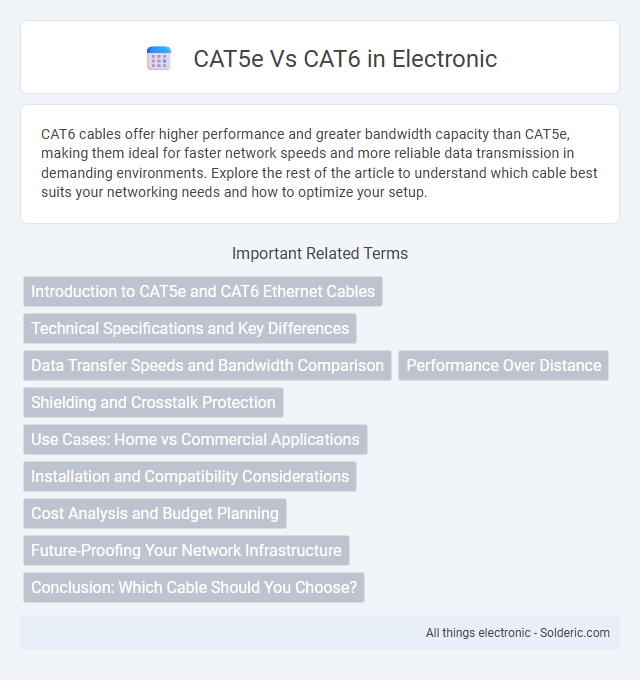CAT6 cables offer higher performance and greater bandwidth capacity than CAT5e, making them ideal for faster network speeds and more reliable data transmission in demanding environments. Explore the rest of the article to understand which cable best suits your networking needs and how to optimize your setup.
Comparison Table
| Feature | CAT5e | CAT6 |
|---|---|---|
| Maximum Speed | 1 Gbps | 10 Gbps (up to 55 meters) |
| Bandwidth | 100 MHz | 250 MHz |
| Cable Construction | Unshielded Twisted Pair (UTP) | Twisted Pair with tighter twists, sometimes Shielded Twisted Pair (STP) |
| Maximum Length for Speed | 100 meters | 55 meters (for 10 Gbps), 100 meters (for 1 Gbps) |
| Interference Resistance | Standard | Better due to improved insulation and shielding |
| Cost | Lower | Higher |
| Use Case | Basic networking, 1 Gbps Ethernet | High-speed networks, 10 Gbps Ethernet in short runs |
Introduction to CAT5e and CAT6 Ethernet Cables
CAT5e Ethernet cables support data transmission speeds up to 1 Gbps with a bandwidth of 100 MHz, making them suitable for most standard home and office networks. CAT6 cables enhance performance by providing up to 10 Gbps speeds over shorter distances and a bandwidth of 250 MHz, ideal for high-speed and gigabit applications. Both cables use twisted pair wiring, but CAT6 incorporates tighter twists and improved shielding to reduce crosstalk and interference.
Technical Specifications and Key Differences
CAT5e cables support up to 1 Gbps speeds at 100 MHz bandwidth, suitable for most home and office networks, while CAT6 cables offer up to 10 Gbps speeds at 250 MHz, enabling faster data transmission over shorter distances. The main technical difference lies in CAT6's improved insulation and reduced crosstalk, allowing for better performance and reliability in high-interference environments. CAT6 cables are often preferred for Gigabit Ethernet and future-proofing due to their enhanced specifications and support for higher frequencies.
Data Transfer Speeds and Bandwidth Comparison
CAT6 cables support data transfer speeds up to 10 Gbps over distances up to 55 meters, compared to CAT5e cables, which handle speeds of up to 1 Gbps over 100 meters. The bandwidth capacity of CAT6 is significantly higher at 250 MHz, whereas CAT5e operates at 100 MHz, supporting more data transmission and reducing crosstalk. For high-performance networks requiring faster speeds and greater bandwidth, CAT6 provides superior performance, especially in environments with heavy data traffic.
Performance Over Distance
CAT6 cables deliver higher performance over longer distances compared to CAT5e, supporting bandwidths up to 250 MHz and data rates of 10 Gbps at distances up to 55 meters. CAT5e cables support bandwidths up to 100 MHz with reliable 1 Gbps speeds over 100 meters. You should choose CAT6 for improved signal integrity and reduced crosstalk when your network demands high-speed transmission over medium distances.
Shielding and Crosstalk Protection
CAT6 cables typically offer superior shielding and crosstalk protection compared to CAT5e, featuring tighter twists and often foil or overall shielding to reduce electromagnetic interference (EMI). CAT5e cables primarily rely on unshielded twisted pairs (UTP), which provide less protection against crosstalk and external noise. For Your network requiring higher performance and stability in environments with significant interference, CAT6 shielding can significantly improve signal integrity.
Use Cases: Home vs Commercial Applications
CAT5e cables are ideal for home networks and small office setups, supporting speeds up to 1 Gbps over distances up to 100 meters, making them cost-effective for everyday internet usage and streaming. CAT6 cables deliver higher performance with speeds up to 10 Gbps over shorter distances (up to 55 meters) and better resistance to crosstalk, making them suitable for commercial environments requiring robust bandwidth for data centers, enterprise networks, and high-demand applications. Choosing CAT6 over CAT5e in commercial applications ensures future-proofing and supports advanced technologies such as VoIP, video conferencing, and large file transfers.
Installation and Compatibility Considerations
CAT5e cables offer greater installation flexibility with looser twist rates and lower cost, making them compatible with most older network devices and easier to handle in tight spaces. CAT6 cables require more precise installation due to tighter twists and thicker insulation, providing better performance but demanding skilled handling to avoid signal degradation. Both cable types support RJ45 connectors, yet CAT6 is ideal for future-proofing higher-speed networks while maintaining backward compatibility.
Cost Analysis and Budget Planning
CAT5e cables are generally more affordable than CAT6, making them a cost-effective choice for budget-conscious projects requiring standard gigabit speeds. CAT6 cables, while pricier, offer higher performance with support for 10Gbps speeds over shorter distances, justifying the investment in environments demanding future-proofing and enhanced network reliability. Your budget planning should weigh the initial cost savings of CAT5e against the long-term benefits of CAT6 in terms of speed, durability, and upgrade potential.
Future-Proofing Your Network Infrastructure
CAT6 cables offer superior performance with higher bandwidth capacity of up to 10 Gbps over 55 meters, compared to CAT5e's 1 Gbps speed at 100 meters, making them a smarter choice for future-proofing your network infrastructure. Investing in CAT6 ensures compatibility with emerging technologies and increased data transmission demands, safeguarding your network against obsolescence. Your network will benefit from enhanced signal integrity and reduced crosstalk, providing reliable connectivity for upcoming advancements.
Conclusion: Which Cable Should You Choose?
CAT6 cables offer higher bandwidth and faster data transfer speeds up to 10 Gbps over shorter distances, making them ideal for future-proofing your network and supporting demanding applications. CAT5e cables remain a cost-effective solution for standard home or office setups with speeds up to 1 Gbps over longer runs. You should choose CAT6 if you require enhanced performance and reliability for gaming, streaming, or professional use, while CAT5e suits basic internet needs and budget-conscious installations.
CAT5e vs CAT6 Infographic

 solderic.com
solderic.com